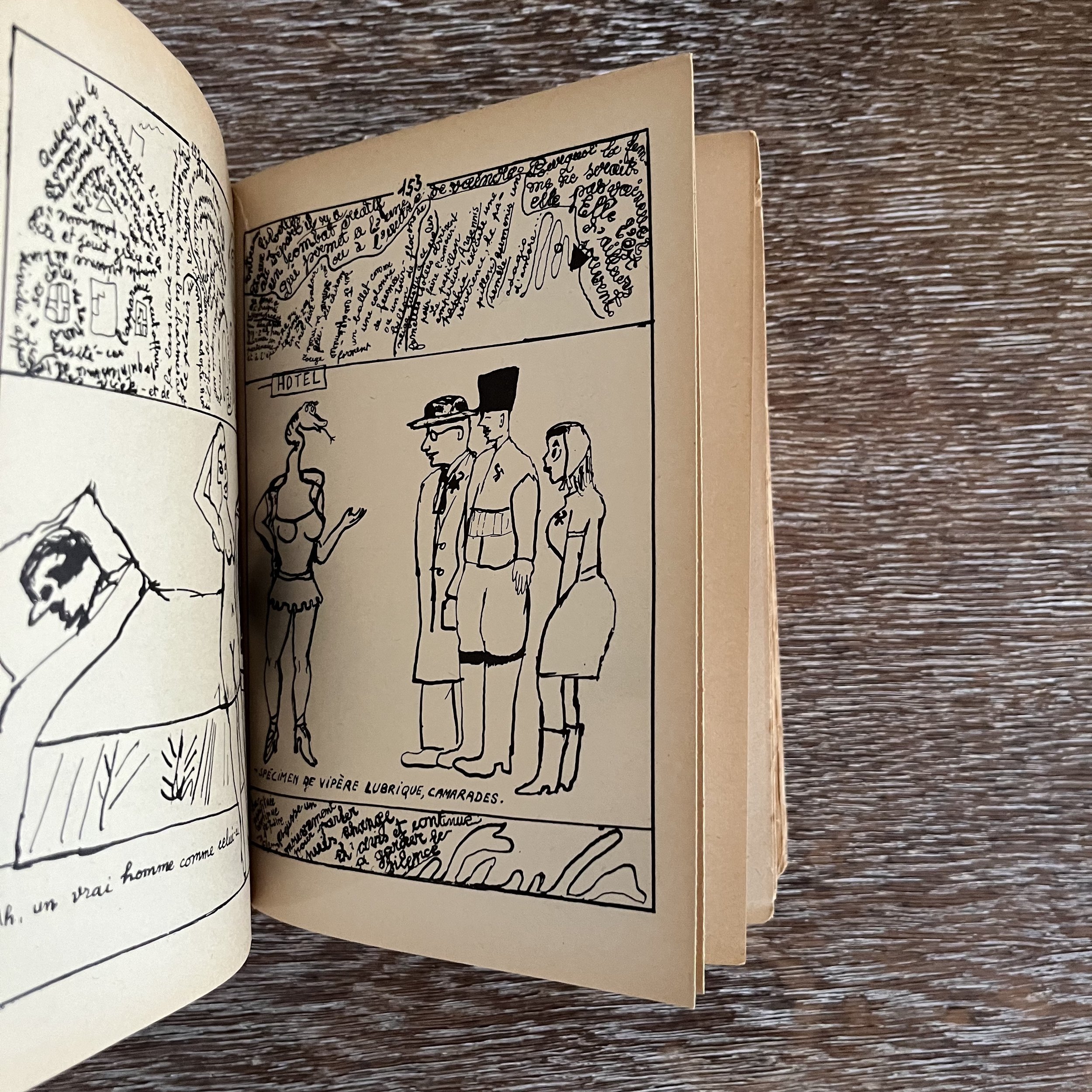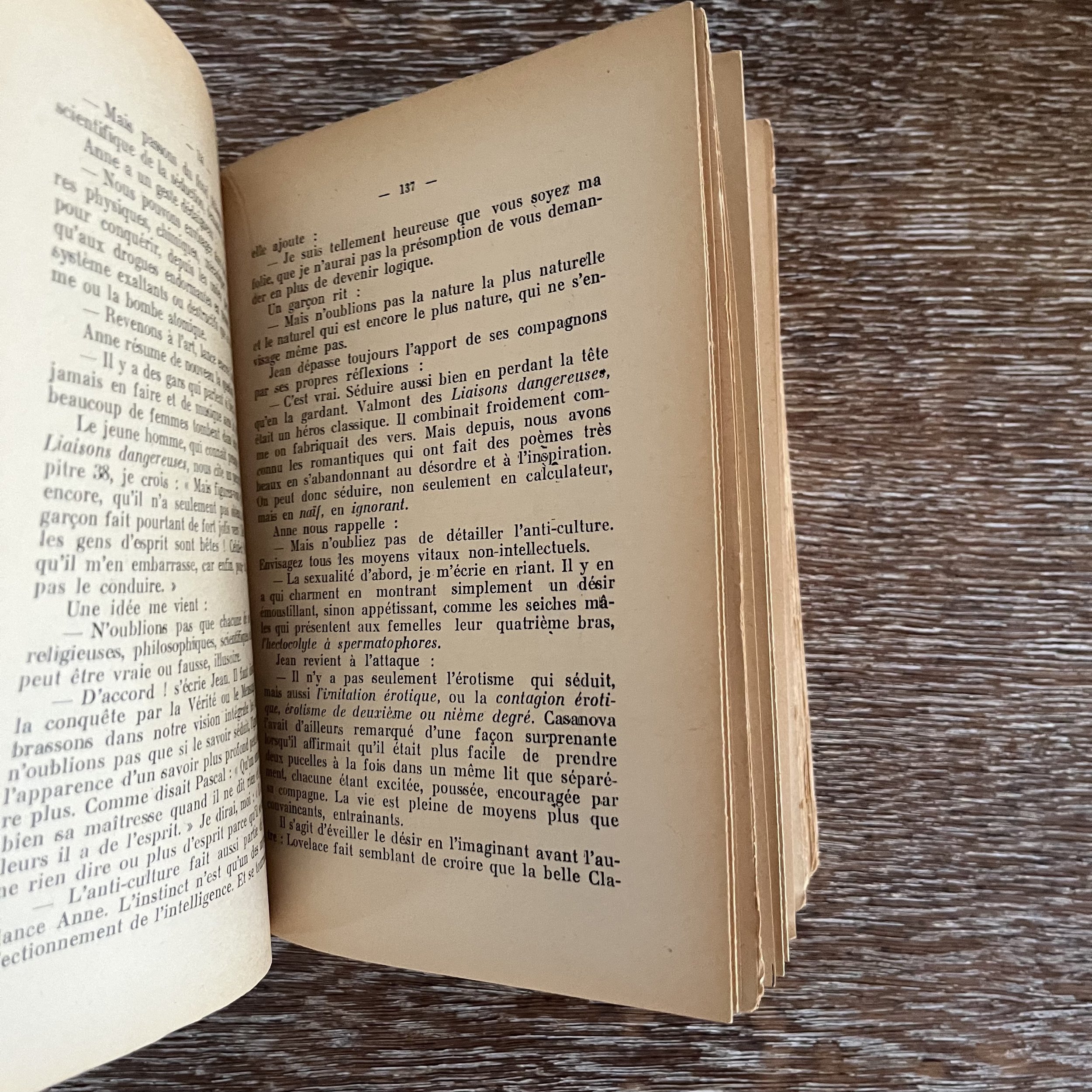 Image 1 of 5
Image 1 of 5

 Image 2 of 5
Image 2 of 5

 Image 3 of 5
Image 3 of 5

 Image 4 of 5
Image 4 of 5

 Image 5 of 5
Image 5 of 5

Initiation a la Haute Volupte by Isidore Isou
ISOU, Isidore Initiation a la Haute Volupte Paris: Escaliers de Lausanne. 1960.
8vo. Cream card wrappers with blue lettering on title page and spine; pp. [4] 7-496; untrimmed pages which are partially unopened; slight foxing on fore-edges, vague bruising on top and bottom spine, otherwise very good.
"Renewal of the erotic/ Revolution of the Art of the Novel" writes Romanian poet and novelist Isidore Isou, responsible for the conception of Lettrism, an obscure French avant-garde movement with origin in 1940's Paris and roots in Surrealism. As a reuslt of his Jewish origins and the opressive ruling of Ion Antonescu in Romania at the time, Isou took exile in Paris. In 1946, he issued his first manifesto, labelling Lettrism as a literary and artistic movement orientated around 'the sign' and appealing for the abolition of words in favor of letters. The erotic Initiation a la Haute Volupte was originally published as a book in 1960 and subsequently inspired a series of silkscreens by Edizioni Conz in 1989. His 1951 film, Traité de bave et d’éternité (Treatise on Slime and Eternity), caused such controversy in Cannes that Jean Cocteau named it "the most beautiful scandal".
Offered on behalf of Henry Sotheran and Co.
ISOU, Isidore Initiation a la Haute Volupte Paris: Escaliers de Lausanne. 1960.
8vo. Cream card wrappers with blue lettering on title page and spine; pp. [4] 7-496; untrimmed pages which are partially unopened; slight foxing on fore-edges, vague bruising on top and bottom spine, otherwise very good.
"Renewal of the erotic/ Revolution of the Art of the Novel" writes Romanian poet and novelist Isidore Isou, responsible for the conception of Lettrism, an obscure French avant-garde movement with origin in 1940's Paris and roots in Surrealism. As a reuslt of his Jewish origins and the opressive ruling of Ion Antonescu in Romania at the time, Isou took exile in Paris. In 1946, he issued his first manifesto, labelling Lettrism as a literary and artistic movement orientated around 'the sign' and appealing for the abolition of words in favor of letters. The erotic Initiation a la Haute Volupte was originally published as a book in 1960 and subsequently inspired a series of silkscreens by Edizioni Conz in 1989. His 1951 film, Traité de bave et d’éternité (Treatise on Slime and Eternity), caused such controversy in Cannes that Jean Cocteau named it "the most beautiful scandal".
Offered on behalf of Henry Sotheran and Co.
ISOU, Isidore Initiation a la Haute Volupte Paris: Escaliers de Lausanne. 1960.
8vo. Cream card wrappers with blue lettering on title page and spine; pp. [4] 7-496; untrimmed pages which are partially unopened; slight foxing on fore-edges, vague bruising on top and bottom spine, otherwise very good.
"Renewal of the erotic/ Revolution of the Art of the Novel" writes Romanian poet and novelist Isidore Isou, responsible for the conception of Lettrism, an obscure French avant-garde movement with origin in 1940's Paris and roots in Surrealism. As a reuslt of his Jewish origins and the opressive ruling of Ion Antonescu in Romania at the time, Isou took exile in Paris. In 1946, he issued his first manifesto, labelling Lettrism as a literary and artistic movement orientated around 'the sign' and appealing for the abolition of words in favor of letters. The erotic Initiation a la Haute Volupte was originally published as a book in 1960 and subsequently inspired a series of silkscreens by Edizioni Conz in 1989. His 1951 film, Traité de bave et d’éternité (Treatise on Slime and Eternity), caused such controversy in Cannes that Jean Cocteau named it "the most beautiful scandal".
Offered on behalf of Henry Sotheran and Co.
